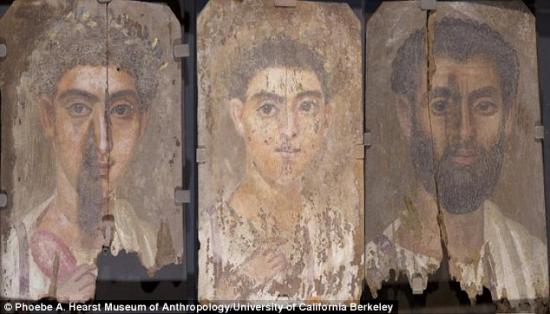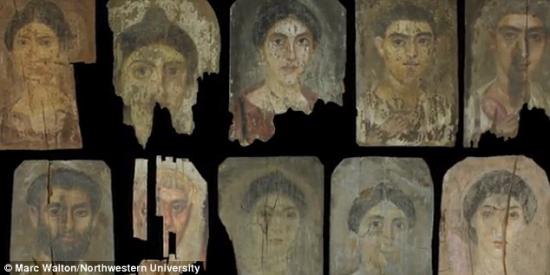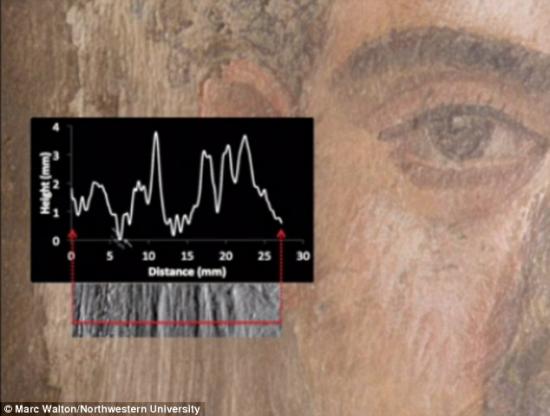Forensic experts discover how the artist used pigments from across Europe
Richard Gray
Source - http://www.dailymail.co.uk/sciencetech/article-3447805/Secrets-2-000-year-old-Egyptian-mummy-paintings-revealed-Forensic-experts-trace-pigments-spread-Europe.html#ixzz40Fw94WpO
Their bright colours and delicate facial features painted onto wood to cover the faces of ancient Egyptian mummies are thought to have influenced later styles of religious paintings in Europe.
But it seems the ancient artists who created these lifelike portraits of the dead in Egypt 2,000 years ago were reliant upon materials from distant parts of Europe to create their masterpieces.
Analysis of a series of so-called 'mummy portraits', discovered at the ancient Egyptian settlement of Tebturnis, in modern day Umm el-Baragat in Al Fayyumm, is finally revealing their secrets.
 A group of 2,000-year-old portraits (pictured three by the same artist) found covering the faces of ancient Egyptian mummies have been found to have been painted using a sophisticated pallet of pigments, many of which were imported form Spain and Greece. The wood they were painted on also comes from central Europe
A group of 2,000-year-old portraits (pictured three by the same artist) found covering the faces of ancient Egyptian mummies have been found to have been painted using a sophisticated pallet of pigments, many of which were imported form Spain and Greece. The wood they were painted on also comes from central Europe
Largely overlooked for the past 100 years in favour of papyri unearthed alongside them, the 15 Roman-era Egyptian wood panel paintings were first unearthed by archaeologists in 1899.
Now scientists have used a series of sophisticated imaging techniques to study the pigments, brush strokes and wood used to create the rare portraits.
Hidden beneath the layers of red and yellow paint, the researchers discovered the artists had sketched out their work with a pigment called Egyptian Blue – highly valuable at the time.
The discovery baffled them because the first pigment to be artificially manufactured and with its vivid colour, it was highly regarded by artists and often used as the final top layer of paint.
However, in these portraits it was hidden beneath other colours.
It was only when the researchers analysed the other pigments that it began to become clear why they might have used this expensive pigment as a base coat.
Their research found that the red lead pigment used in the paintings had come from as far away as Spain.
Other pigments appear to have been imported from Keos in Greece while the wood on which the portraits were painted on came from Central Europe.
The findings, made by researchers at Northwestern University and University of California Berkeley's Phoebe A. Hearst Museum of Anthropology, suggest the Egyptian artists had relied upon vast trade networks to obtain their materials.
Dr Marc Walton, a materials scientist at Northwestern University who led the research, it could help to shed light on where techniques used artists in the Byzantine Empire came from.
'Roman-Egyptian portraits were created in Egypt from the 1st-3rd centuries AD,' he said.
'Painted on wooden panels, often using wax and originally attached to mummies, these visages of the dead are considered to be antecedents of Western portraiture.
'Our materials analysis provides a fresh and rich archaeological context for the Tebtunis portraits, reflecting the international perspective of these ancient Egyptians.
 The researchers took microscopic samples of paint from the portraits and examined the pigments (pictured). They found the red lead pigment appears to match those produced in Spain at the time while the iron-earth pigments, like the yellow ochre jarosite, came from Keos in Greece
The researchers took microscopic samples of paint from the portraits and examined the pigments (pictured). They found the red lead pigment appears to match those produced in Spain at the time while the iron-earth pigments, like the yellow ochre jarosite, came from Keos in Greece
 There were 15 exquisitely preserved portraits (pictured) discovered at the site of Tebtunis by archaeologists in 1899. However, they were largely overlooked as experts concentrated on papyri found with them
There were 15 exquisitely preserved portraits (pictured) discovered at the site of Tebtunis by archaeologists in 1899. However, they were largely overlooked as experts concentrated on papyri found with them
'For example, we found that the iron-earth pigments most likely came from Keos in Greece, the red lead from Spain and the wood substrate on which the portraits are painted came from central Europe.
'We also know the painters used Egyptian blue in an unusual way to broaden their spectrum of hues.'
Roman-era mummy portraits from Egypt are widely thought to have adapted some of the styles used by Greek artists to create striking head-on images.
These techniques were later adopted in icon images of Christ, the Virgin Mary and angels in the orthodox Christian and Catholic Church.
The portraits found at Tebtunis are considered to be some of the best preserved paintings from the period and are among the most important collections in the world.
Researchers used a combination of non-destructive imaging techniques and took tiny samples of paint to study how the portraits were made.
They were also able to work out the order in which various parts of the painting were built up and could examine the brush strokes and tool marks on the portraits.
Dr Walton said: 'The specific information obtained about painting methods and overall distribution of pigments produces groupings of portraits of similar materials and has led to the identification of ancient workshops and the hand of specific artists.
'Our goal is to use objects themselves as evidence for their production.
'In our interrogation, we have used a number of cutting-edge analytical tools developed here at Northwestern to uncover new and intriguing clues about how to identify the hand of an individual artist.'
 The researchers also used a series of imaging techniques to analyse the pigments that were used on the paintings (pictured) to help them assess the types of pigments and techniques the artists used
The researchers also used a series of imaging techniques to analyse the pigments that were used on the paintings (pictured) to help them assess the types of pigments and techniques the artists used
 Imaging of the brush techniques (pictured) helped them identify three of the ancient portraits that appear to have been created by the same artist
Imaging of the brush techniques (pictured) helped them identify three of the ancient portraits that appear to have been created by the same artist